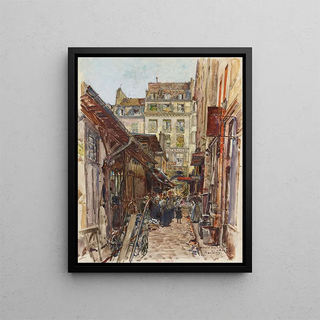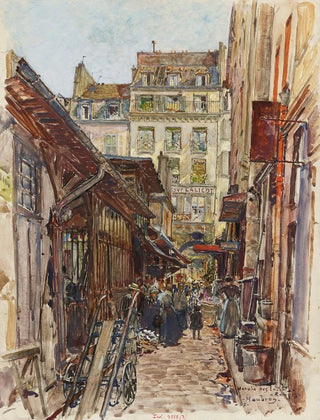Art print | Interior of the Marché des Enfants Rouges in 1907 3rd arrondissement - Frédéric Houbron


View from behind

Frame (optional)
Interior Art print of the Marché des Enfants Rouges in 1907 3rd arrondissement - Frédéric Houbron – Captivating introduction
In the vibrant heart of Paris, the Marché des Enfants Rouges stands as a testament to daily life in the early 20th century. Frédéric Houbron, with his keen eye and artistic sensitivity, immortalizes this lively space on his 1907 canvas. The work, both a tribute to the vitality of Parisian markets and an exploration of human interactions, transports the viewer to a bygone era. Through his brushstrokes, Houbron does not merely depict a place but captures the very essence of urban life, inviting everyone to feel the buzz that reigned around these colorful stalls.
Style and uniqueness of the work
Houbron’s work is distinguished by its impressionist style, characterized by vibrant color strokes and delicate light playing across surfaces. In "Interior of the Marché des Enfants Rouges," the artist uses warm shades to evoke the convivial atmosphere of the market. The characters, though sometimes sketched, are animated with palpable life, their gestures and expressions conveying the richness of a shared moment. The composition is carefully orchestrated, blending the movement of customers with stalls laden with fresh produce. This painting is not limited to a simple representation; it offers an immersion into a universe where daily life becomes a celebration of Parisian culture. The use of perspective enhances this sense of depth, placing the viewer at the heart of the action.
The artist and his influence
Frédéric Houbron, less known than some of his contemporaries, deserves special attention for his ability to capture the soul of his era. Trained within Parisian artistic circles, he managed to incorporate impressionist influences while developing his own voice. His work reflects not only his talent but also a time when art was freeing itself from academic conventions to explore new forms of expression. Through his works, Houbron reminds us of the importance of community gathering places, human exchanges, and the beauty of fleeting moments. His perspective on the Marché des Enfants Rouges transcends simple representation, offering a reflection

Matte finish

View from behind

Frame (optional)
Interior Art print of the Marché des Enfants Rouges in 1907 3rd arrondissement - Frédéric Houbron – Captivating introduction
In the vibrant heart of Paris, the Marché des Enfants Rouges stands as a testament to daily life in the early 20th century. Frédéric Houbron, with his keen eye and artistic sensitivity, immortalizes this lively space on his 1907 canvas. The work, both a tribute to the vitality of Parisian markets and an exploration of human interactions, transports the viewer to a bygone era. Through his brushstrokes, Houbron does not merely depict a place but captures the very essence of urban life, inviting everyone to feel the buzz that reigned around these colorful stalls.
Style and uniqueness of the work
Houbron’s work is distinguished by its impressionist style, characterized by vibrant color strokes and delicate light playing across surfaces. In "Interior of the Marché des Enfants Rouges," the artist uses warm shades to evoke the convivial atmosphere of the market. The characters, though sometimes sketched, are animated with palpable life, their gestures and expressions conveying the richness of a shared moment. The composition is carefully orchestrated, blending the movement of customers with stalls laden with fresh produce. This painting is not limited to a simple representation; it offers an immersion into a universe where daily life becomes a celebration of Parisian culture. The use of perspective enhances this sense of depth, placing the viewer at the heart of the action.
The artist and his influence
Frédéric Houbron, less known than some of his contemporaries, deserves special attention for his ability to capture the soul of his era. Trained within Parisian artistic circles, he managed to incorporate impressionist influences while developing his own voice. His work reflects not only his talent but also a time when art was freeing itself from academic conventions to explore new forms of expression. Through his works, Houbron reminds us of the importance of community gathering places, human exchanges, and the beauty of fleeting moments. His perspective on the Marché des Enfants Rouges transcends simple representation, offering a reflection






